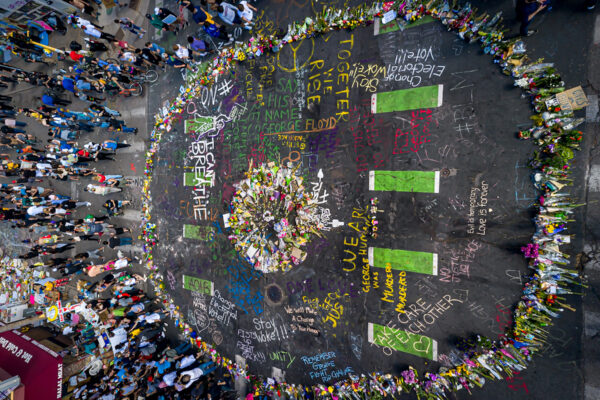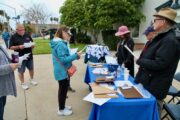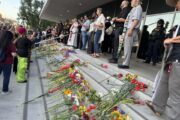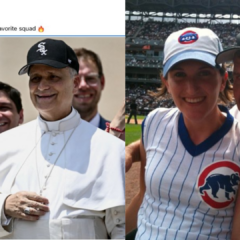This article was originally published in the Berkley Forum as an editorial response to “Religion and Racial Justice: The George Floyd Protests.”
A circle of flowers forms a sanctuary honoring the space where George Floyd was murdered by police. According to residents I talked to, like Larry Holderfield, the inner sanctum of that circle of flowers is referred to as “church” by the community. Inside the ring, messages like “We are human,” “Together we rise,” and “Take care of each other,” are etched in multi-colored chalk.
Mourners enter the inner sanctum as if entering a holy space. They quiet themselves. They kneel. They cry. They sit in silence to reflect and grieve. The sites where black people are killed by police often become altars—sacred spaces to mourn Black death.
Black Lives Matter (BLM) chapters, along with organizations affiliated with the larger movement for Black lives, channel deep grief and trauma caused by racial injustice into political action through a spiritually informed movement. They are fueled by a faith that consistently celebrates Black life. Too often, this spiritual community is missed or ignored in lieu of a focus on dissent. It is also often ignored in discussions of religion and racial justice.
On June 2, 2020, Black Lives Matter’s Los Angeles Chapter sponsored an action in front of Mayor Eric Garcetti’s house, demanding reductions in the city’s funding of police. The action, what many would call a protest, began like a religious ceremony. Melina Abdullah, chair of the Department of Pan-African Studies at California State University, Los Angeles, and co-founder of BLM-LA, opened the event explaining that while the movement is a social justice movement, it is first and foremost a spiritual movement.
She led the group in a ritual: the reciting of names of those taken by state violence before their time—ancestors now being called back to animate their own justice:
“George Floyd. Asé. Philandro Castille. Asé. Andrew Joseph. Asé. Michael Brown. Asé. Erika Garner. Asé. Harriet Tubman. Asé. Malcom X. Asé. Martin Luther King. Asé.”
As each name is recited, Dr. Abdullah poured libations on the ground as the group of over 100 chanted “Asé,” a Yoruba term often used by practitioners of Ifa, a faith and divination system that originated in West Africa, in return. This ritual, Dr. Abdullah explained, is a form of worship.
Those participating see themselves as the carriers of the tradition. The inheritors of the duty to protect Black life. The movement for Black lives sees itself as the current embodiment in a legacy of spirit-infused social justice work. There is a veneration for the sacred duty of the freedom fighter and a dream for the day it will no longer be necessary. There is a belief system, grounded in principles like radical inclusion, which posits it is imperative to center the experience of the most marginalized and sanctify all forms of Black life.
The BLM network has embraced female and queer leadership along with membership often shunned and/or marginalized by traditional faith groups, thus disrupting a legacy of civil rights leadership that is largely hetero-normative and almost exclusively male.
The movement for Black lives works towards the goal of not just racial justice, but freedom of the mind and the spirit. It encourages “healing justice,” so that people can heal from trauma and engage as the best version of themselves. The movement infuses a syncretic blend of African and indigenous cultures’ spiritual practices and beliefs, embracing ancestor worship; Ifa-based ritual such as chanting, dancing, and summoning deities; and healing practices such as acupuncture, reiki, therapeutic massage, and plant medicine in much of its work, including protest. That work, though, often remains invisible.
Importantly the movement’s deep embeddedness in communities is also often invisible. When George Floyd was killed, many Black Lives Matter chapters and affiliated organizations had been working on pandemic response. Dignity and Power Now in Los Angeles successfully agitated on behalf of prison populations facing COVID-19 while ensuring health access and testing sites for communities directly impacted by state violence. Patrisse Cullors, a co-founder of BLM, spent her time in COVID-19 lockdown working on Black health access, creating a “Care not Cages” platform and suing the Los Angeles County Sheriff’s department on behalf of inmates being denied testing and treatment. As a person ordained in Ifa, she also led meditations that allowed participants to better imagine the future while advocating for self-care, mental health awareness, healing justice, and art activism during the pandemic.
On May 8, in response to the murder of Ahmaud Arbery, Patrisse penned a prayer:
“They hunted
you.
They hunted
you like they hunted our ancestors. And our ancestors, ancestors.
And so this
prayer, this prayer that I have is for you, Ahmaud.
For you
and your family and every Black person inside of Brunswick, Georgia.
I pray for
you. And I know you pray for me. And I know they pray every single day.
We pray
as a collective.
There’s
a collective prayer that we got taught from our ancestors and their ancestors.
There’s
a collective prayer and that prayer is grounded in the idea and the belief that one day we will be free.
Free from
the bondage of white supremacy. Free from the ways it makes us contort ourselves. Free from the ways that it makes us shrink ourselves.
Free from
the ways that it makes us run from ourselves.
I know we
will be free. I can feel it. I can smell it. I can see it.”
Since the inception of the movement in 2013, Black Lives Matter chapters and affiliated groups have sought to impart meaning, heal grief and trauma, combat burn-out, encourage political change and transformative justice.
The BLM approach necessitates that communities work to dismantle systems of oppression not only in the state, but also between communities, within communities, in families, in gender relations, in religious practice, and ultimately, within oneself.
Some see BLM as secularizing the new civil rights movement. Instead, BLM’s marginalization of patriarchal and hierarchical modalities of religion informs its members’ reinterpretation and expression of faith, political expression, radical organizing, and community-building. The movement for Black lives restores members’ humanity, even in the face of state violence and predatory policing.
As traditional faith institutions face crises of trust, relevance, and membership, this moment presents them with the opportunity to reexamine norms around the inherent dignity of human life as they grapple with their role in the mounting imperative for meaningful action.
“There are many spiritualities that further repress and subjugate people in their communities, but I’m calling for spirituality to be deeply radical in its ability to heal people,” Patrisse explains. “I don’t think we’re people to be fixed, but rather how do we hold faith for people who’ve had harm caused to them in a way that makes them feel like they have agency again? That’s what spirituality has the ability to do.”
For, as Patrisse puts it, “The fight to save your life is a spiritual fight.”
Photo Courtesy of Carlos Montenegro
Hebah Farrag was the assistant director of research of the USC Center for Religion and Civic Culture through 2023.







